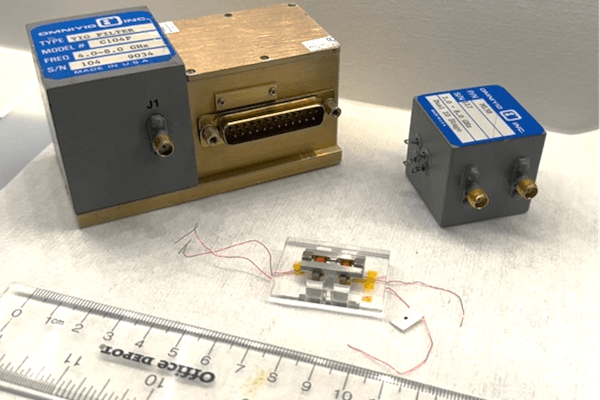Tech
6G wireless signals possible thanks to revolutionary quarter-sized filter

PHILADELPHIA — If you’ve ever used a smartphone, streaming device, or any other wireless gadget, you’ve experienced the magic of radio frequency (RF) filters first-hand. These unsung heroes sort through the jumbled mess of signals bouncing around the airwaves to tune in exactly the frequencies your device needs while blocking out all the noise and interference. Now, a revolutionary new filter that’s as small as a quarter could soon open the door to 6G wireless signals!
Researchers from Penn Engineering explain that as new technologies like 5G and eventually 6G roll out with a rapidly expanding number of wireless bands, the old approach of using separate fixed filters for each channel is becoming unsustainable. It would be like needing a different bodyguard to get you into every room you enter. The complexity and inefficiency would be overwhelming.
That’s why an innovative new “filter-of-all-trades” developed by engineers at the University of Pennsylvania could be a game-changer. It’s a single miniature filter that can dynamically tune itself to allow any desired frequencies through while keeping the riffraff out. One filter to rule them all, so to speak.
“I hope it will enable the next generation of wireless communications,” says Troy Olsson, an associate professor in Electrical and Systems Engineering (ESE) at Penn Engineering and the senior author of the new study in Nature Communications.
The key lies in an ultra-thin film of a magnetic material called yttrium iron garnet (YIG). When exposed to a magnetic field, this YIG film can generate microscopic waves called magnetostatic waves that resonate at different frequencies depending on the strength of the applied magnetic field.
It’s similar to how tightening or loosening a guitar string changes the pitch of the vibrations. Except in this case, the “strings” are formed by spin waves rippling through the molecular force fields of magnetized atoms. By carefully manipulating the magnetic field across the YIG film, the frequencies of these magnetostatic waves can be continuously tuned.
One of the toughest challenges was figuring out how to generate that tunable magnetic field in an ultra-compact, low-power package suitable for today’s slim mobile devices and internet sensors. Traditional YIG filters often rely on bulky, power-hungry electromagnets the size of a soda can – completely impractical for modern smartphones and wireless gear.
The Penn Engineers cracked this with a remarkably simple yet brilliant magnetic tuning circuit roughly the size of a couple of AA batteries. It combines a permanent magnet with movable “programmable” magnets that can reshape the magnetic field pattern on demand using short electrical pulses. But here’s the ingenious part – once the movable magnets lock into the desired magnetic state, the circuit uses literally zero power to maintain that magnetic tone.


Their proof-of-concept filter is a mere 1.68 cubic centimeters – about the size of the typical little Lego figure. Yet this tiny device can tune across an incredibly wide range of frequencies from 3.4 to 11.1 gigahertz, spanning the entire planned 6G spectrum and more in one continuously tunable filter.
“Right now we work from 600 MHz to 6 GHz,” Olsson explains. “That’s 5G, 4G, 3G.”
“The FR3 band is most likely to roll out for 6G or Next G,” Olsson continues, referring to the next generation of cellular networks, “and right now the performance of small-filter and low-loss switch technologies in those bands is highly limited. Having a filter that could be tunable across those bands means not having to put in another 100+ filters in your phone with many different switches. A filter like the one we created is the most viable path to using the FR3 band.”
However, it’s not just about that phenomenal tuning range. The filter also exhibits exceptionally low signal loss of merely three to five decibels and outstanding rejection of interference signals in off-frequency bands. Those are hugely important traits for preventing wireless cross-talk and preserving signal integrity in congested environments.
While the most obvious initial application is streamlining the radio frequency front-ends of smartphones and internet devices, the potential impacts extend far beyond consumer mobile products. This tunability could be transformative for cognitive radios, satellite communications, multi-band radar systems, and mitigating interference at base stations for 5G, 6G, and other advanced wireless networks.
“Being tunable is going to be really important,” Olsson continues, “because at these higher frequencies you may not always have a dedicated block of spectrum just for commercial use.”
Just as quartz crystals enabled the precise timing circuits now embedded across all electronics, these magnetostatic tunable filters could become an essential building block for any system requiring intelligent filtering and frequency agility over a wide swath of the radio spectrum.
The ability to instantaneously hop between any wireless frequencies in a tiny, low-power package opens up new possibilities for how multi-frequency systems are designed and how we efficiently manage the increasingly crowded and precious commodity of radio spectrum. Whether streaming ultra-HD movies, operating fleets of self-driving vehicles, or orchestrating future smart city operations, these tunable filters may harmonize the wireless symphony of our hyper-connected world.
StudyFinds Editor Chris Melore contributed to this report.










